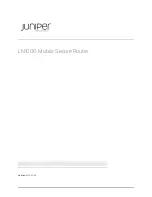
DRA-2 UNIVERSAL COMMUNICATION NODE
73/158
USER GUIDE - Rev.5 (January 2018)
•
ABR Type:
This field allows to change the behaviour of the router. In default
conditions, it is according to the standard, but it admits as alternative options
cisco
and
ibm
values, which are equivalent. When the value is different from
standard
,
the router can consider the messages received from other ABR through areas
other than the backbone, when in normal conditions would not. Behaviour change
is consistent with the implementation described in Cisco routers and IBM. It must
be taken into account that areas with full adjacency through virtual links are
considered with full capacity for transit. In this way, they can be used to route the
traffic of the backbone, and this configuration do not affect them.
•
Enabled interfaces:
This has three values, the first being an IP address or range
of IP addresses, which means that the interface or interfaces whose IP addresses
are included in the referred range will execute the OSPF protocol, and their area
will be that indicated by the
Area
parameter (second parameter); despite the fact
that it is usually represented as an IP address, it is the element identifying the Area
to which the interfaces included by the first value are connected. All the routers with
interfaces operating in the same area share that identification element. The area
with the identifier 0.0.0.0 is valid and acts like a backbone, since all the areas must
be connected to it. The third parameter determines whether messages for the
defined area should provide and require authentication, using MD5 for it. The value
for the calculation of the hash must be configured in the following section of
interface configuration given that, with different interfaces of the same area, it is
possible to use different keys.
•
Interface configuration:
The interfaces on which the protocol runs allow the
modification of various parameters associated with them. The parameters are:
o
Interface:
Identification of the interface to be configured.
o
Cost:
Cost associated with the link for the interface. The cost is the value
used in the field associated with the metric of the router-LSA messages
and it will be used to calculate the SPF algorithm (Shortest Path First). The
default value is 5.
o
Hello interval:
Sets the value, in seconds, of the timer that controls the
transmission of the
Hello
messages. The default value is 10 s.
o
Dead interval:
Sets the value, in seconds, of the timer that monitors the
inactivity and waiting processes of the remote routers. The default value is
40 s.
















































